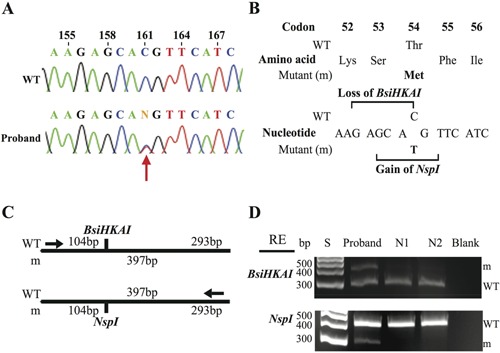Figure 2.

Identification of a Thr54Met GNA11 mutation in a FHH proband. (A) DNA sequence analyses revealed a heterozygous C‐to‐T transition at nucleotide c.161 (red arrow) within exon 2 of GNA11. (B) This sequence abnormality was predicted to lead to a missense amino acid substitution of Thr to Met at codon 54, resulting in the loss of a BsiHKAI restriction endonuclease site (GAGCA/C) and gain of an NspI (GCATG/T) restriction endonuclease site. (C) Restriction maps showing that BsiHKAI digestion would result in two products of 104 bp and 293 bp from the wild‐type (WT) sequence but not the mutant (m) sequence. In contrast, NspI digestion results in two products of 104 bp and 293 bp from the m sequence but not the WT sequence. (D) Restriction endonuclease (RE) digest of PCR products of exon 2 of GNA11 demonstrating the heterozygous C‐to‐T transition and confirming its absence in two unrelated unaffected individuals (N1 and N2). S = size marker. For BsiHKAI RE digest the mutant product (397 bp) and WT product (293 bp) are shown; the WT product at 104 bp is not shown. For NspI RE digest the WT product (397 bp) and mutant product (293 bp) are shown; the mutant product at 104 bp is not shown.
